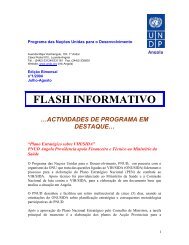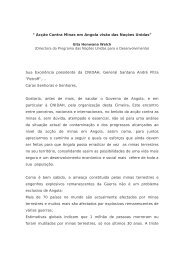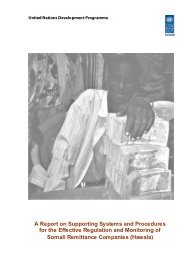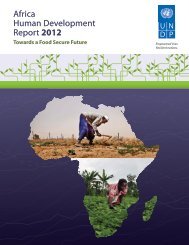CORRUPTION AND ANTI-CORRUPTION STRATEGIES ... - UNDP
CORRUPTION AND ANTI-CORRUPTION STRATEGIES ... - UNDP
CORRUPTION AND ANTI-CORRUPTION STRATEGIES ... - UNDP
Create successful ePaper yourself
Turn your PDF publications into a flip-book with our unique Google optimized e-Paper software.
often a form of redistribution of money from<br />
those in poverty to the office-holding rich<br />
(although there are a number of instances<br />
where low-level and often very poorly paid<br />
officials have responded to the failure of the<br />
state to pay them their official wages over long<br />
periods by selling their resources – for example,<br />
the sale of drugs by health care officials in<br />
Africa – to generate an equivalent source of<br />
income). Corruption is also infinitely varied in<br />
its character in regimes, institutions and groups<br />
across developing economies and is often subject<br />
to differing approaches and attention depending<br />
on its political significance or its societal<br />
impact; for example, 'grand' or high-level<br />
corruption versus low-level corruption; judicial,<br />
administrative and legislative corruption; or<br />
corruption in various public services.<br />
Academic interest and policy-making concern<br />
with the costs of corruption in developing and<br />
transitional countries have also varied considerably<br />
since the 1960s: general theoretical surveys<br />
in the 1960s and 1980s have given way to<br />
systemic studies and more detailed empirical<br />
work, for example in relation to economic<br />
liberalisation in the People's Republic of<br />
China. Academic fashions have echoed policymaking<br />
concerns and “moral panics” about<br />
corruption. The current substantial upsurge in<br />
academic and policy interest in the (damaging)<br />
costs of corruption in the mid-1990s is a product<br />
of growing concern about the perceived growth<br />
in serious corruption worldwide. Since the<br />
1960s, academic debates have reflected some<br />
donor and government policy priorities: with<br />
modernisation and infrastructural growth in<br />
the 1960s; with equity and access in the early<br />
1980s; and with structural adjustment, good<br />
(and bad) governance, economic and political<br />
liberalisation, and deregulation in the late<br />
1980s and 1990s (Charlick, 1993; Doig, 1995;<br />
Harsch, 1993; IDS, 1996; Riley, 1993).<br />
Incidental corruption is a feature of life in<br />
almost all societies, but it can be systematic<br />
in many public institutions in developing<br />
countries, if not systemic in society as a whole<br />
(Riley, 1983), and it can be both endemic and<br />
planned. In many country cases, a key source<br />
of corruption may be a self-serving political<br />
leadership and a large, inefficient and politicallyinfluenced<br />
and misdirected state framework<br />
within which individual and group private<br />
interests have priority over the collective good.<br />
Public officials have considerable discretion to<br />
accumulate private wealth through exploiting<br />
their monopolistic, low and irregularly paid<br />
positions, often in collusion with politicians<br />
and indigenous or foreign businessmen.<br />
Corruption thus frequently takes place in<br />
societies where there is considerable discretion<br />
for public officials, limited accountability and<br />
little transparency in governmental operations;<br />
in such societies, civil society institutions and<br />
an independent private sector are often weak or<br />
undeveloped. The establishment of corruption<br />
on a systematic or systemic basis may be a<br />
consequence of the perpetuation of existing<br />
inequalities and weak ('soft' or 'hollow' states)<br />
where it can thrive “on disorganisation, the<br />
absence of stable relationships among groups<br />
and of recognised patterns of authority”<br />
(Huntington, 1968, p. 710; Andreski, 1970)<br />
but its permanence may rest in a self-supporting<br />
dynamic because it adapts or displaces according<br />
to circumstance and context and thus its<br />
demise should not necessarily be “associated<br />
with political modernisation. Neither is<br />
corruption doomed to destruction as a political<br />
system matures. Corruption alters its character<br />
in response to changing socio-economic cultural<br />
and political factors. As these factors affect<br />
corruption, so does corruption affect them”<br />
(Werner, 1983, p. 638). At the same time,<br />
while it may be difficult to perceive “that<br />
public administration can even aspire to, let<br />
alone sustain, acceptable levels of honesty and<br />
efficiency against a background of punishing<br />
indebtedness, galloping inflation, chronic<br />
unemployment, dismal standards of living and<br />
the serious civic strains that such conditions<br />
inevitably produce, ...to assert that corruption<br />
is simply a consequence of underdevelopment<br />
runs the risk of embracing a rude evolutionism<br />
which envisages a proportionate decline in the<br />
volume of abuse with each percentage improvement<br />
in GDP” (Theobald, 1990, p. 164).<br />
<strong>CORRUPTION</strong>& INTEGRITY IMPROVEMENT INITIATIVES IN DEVELOPING COUNTRIES<br />
4 9







